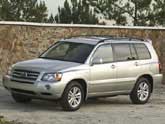Recent Articles
Popular Makes
Body Types
2006 Toyota Highlander Hybrid First Drive
Toyota builds the first seven-passenger green machine
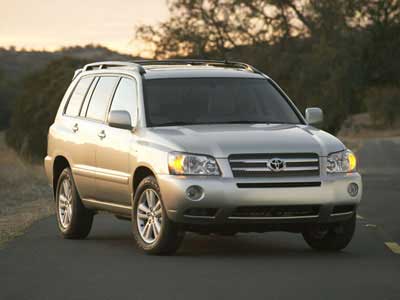
PHOENIX - If you've devoted any of your attention to the automotive world in the last few years, you're well aware of the buzz surrounding hybrid technology. Some of the hype has stemmed from the public's demand for conservation-oriented, fuel-efficient vehicles, but much of the excitement has resulted from the industry's self-promotion.
For years, Ford has championed its "world's-first" hybrid SUV, the Escape; GM eagerly exposed its joint effort with DaimlerChrysler to create an advanced hybrid system; and Honda quietly, yet conspicuously, revealed the Accord Hybrid, an automobile for those consumers who want to let others know they're not making a statement. Or something like that.
To Toyota, however, this is an old game. The widely-popular - and widely-practical - Prius has been around since the 2000 model year, and is already in its second skin. Sure, Honda has offered the Insight hybrid for just as long, but its two-seat configuration, flat rear deck with no enclosure for luggage, and odd-ball styling have stifled sales. And, the Honda Civic Hybrid, first delivered to U.S. customers in 2003, has neither made the type of impact, nor commanded the respect that the Prius enjoys.
Toyota planned it perfectly. When the hybrid craze truly exploded a year or two ago, this Japanese automaker already had a production vehicle in U.S. showrooms. Better yet, all Prius models were developed with the gas/electric powertrain, so the consumer experiences instant recognition, plus a measure of status, for piloting one. By comparison, cross paths with a Civic Hybrid on a two-lane road and you'd likely never suspect its energy-efficient surname.
But as the technology improves, customers are now expecting electric supplementation across the manufacturers' lineups. That is, increasing numbers of mainstream vehicles will propel themselves via both combustion and electrons. Undoubtedly, the result should be positive, as hybrid vehicles will likely lose the status-fulfillment feature and, instead, just require less fueling.
Welcome to the Toyota Highlander Hybrid. Toyota points out that with this vehicle's introduction; it is the first automaker to sell a 7-passenger hybrid SUV. (Ford's Escape Hybrid ferries five.) This makes Toyota unique in offering both a mid-sized passenger car and a mid-sized SUV that utilize dual power sources.
Hybrid Powertrain
The 2006 Toyota Highlander Hybrid is based on the Highlander SUV that first arrived in 2001, which itself was a modified version of the 1998 Lexus RX 300. Upgraded significantly in 2004, with a bigger engine, an upgraded transmission, and third-row seating, the Toyota Highlander now adds a Hybrid version that benefits from all recent upgrades and, at the same time, borrows technology from the Prius, using a variation of its Hybrid Synergy Drive powertrain.
For this newest application of Hybrid Synergy Drive, the battery is larger and the electric motor spins twice as fast, developing twice the power. Combined with a 3.3-liter, DOHC, 24-valve V6 gasoline engine that produces 230 horsepower and 242 lb.-ft. of torque, the Hybrid Synergy Drive system in the 2006 Toyota Highlander Hybrid is good for 268 horsepower. Toyota boasts that it delivers the performance of a V8, and says that the hybrid model is expected to outrun the gasoline version of the standard Highlander in some performance tests, such as acceleration from zero to sixty, for instance. Toyota reports a time in the low 7-second range, with the 4WD version paradoxically making the run faster.
To properly modulate power delivery, Toyota employs an electronically controlled continuously variable transmission (CVT) with a planetary gear unit for gear reduction and an electronic all-wheel-drive control system. The engine benefits from revisions to the Variable Valve Timing with intelligence (VVT-i) and Electronic Throttle Control systems (ETC) that provide smooth integration with the hybrid system. In the mid-size SUV segment, utility is important, and this transmission should help the Highlander Hybrid maximize load-carrying ability. The Highlander Hybrid can tow up to 3,500 lbs., as compared to the smaller Escape Hybrid, which is rated to tow 1,000 lbs.
The CVT will also help contribute to fuel economy that is usually associated with compact, "econo-box" sedans. Toyota claims 30 mpg in a combined city and highway cycle for the 2WD model, and 28 mpg for the 4WD version. The deal with many hybrids, of course, is that mileage increases in the city, because the engine shuts itself off at stops and regenerative braking charges the battery. So a "combined" cycle is highly variable, depending on your style of driving.
With 2WD, the 2006 Toyota Highlander Hybrid's front wheels do the driving. The available 4WD-i system (i, for intelligence) is supplemented by front and rear electric motors that provide a proper balance of power to all four wheels, when needed. This "on-demand system" electronically varies torque from the front, which is the standard drive mode, to the rear, depending on traction needs. Fully-independent MacPherson strut suspension, power-assisted rack-and-pinion steering, and four-wheel-disc brakes with ABS highlight and support Highlander's hardware.
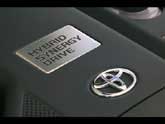
Design
From the outside, Highlander Hybrids look largely unchanged from their gasoline-only siblings, with the exception of a revised front grille and bumper (larger air inlets for improved cooling), rear LED taillights (use less power, have a longer life and illuminate more quickly for a speedier reaction time in those following), extra chrome trim, and standard 17-inch alloy wheels. Rear badges indentify both the Hybrid and 4WD-i versions.
Interior changes are relatively minor and mostly provide information about the hybrid system. The shift pattern is changed to P,R,N,D, and B for braking, which is similar to the lock-out switch on an overdrive transmission, and helps to regenerate energy through engine braking when coming to a stop, slowing, or descending hills. Optitron gauges include indicator lights that show the status of the main battery, as well as a power meter that replaces the tachometer and displays the total output of the engine and electric motors as well as energy recovery. The power meter also has a "blue zone" that depicts regenerative energy and engine braking power. In versions without a navigation screen, the multi-functional display adds an energy flow monitor and current fuel economy to other typical data, such as individual trip odometer, outside temperature, and average fuel economy.
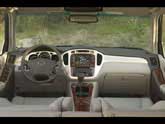
Equipment
Stepping inside the 2006 Toyota Highlander Hybrid, passengers enjoy three rows of seats in all models along with rear privacy glass, cupholders, and rear heating. The third-row seats, relatively comfortable for two small-sized adults or children, are adequately configurable, with "walk-in" steps to aid the climb into the way-back bench. The adjustable-length rear seats fold flat and the 60/40-split second-row bench folds and slides to ease both cargo and passenger loading. Air conditioning, cruise control, and a tilt wheel are all standard, as are all the expected electronics.
Limited models can be equipped with a 7-inch touch-screen navigation system and, when selected, it includes a screen with information about three data fields, making it a veritable science-fair program. The Energy Monitor Screen monitors the system and displays the energy flow from the engine, electric motor and high voltage battery; the Consumption Screen shows current and historical fuel economy in 5-minute increments and 50-watt hour increments of regenerated energy; and the Caution Screen reminds you that you will not recharge the high voltage battery when you leave the 2006 Toyota Highlander Hybrid in neutral - to recharge it must be placed in park.
Electronic stability assistance is courtesy of a new Vehicle Dynamic Integrated Management (VDIM) system that uses several sensors to modulate the brakes and throttle position when trouble arrives. Toyota says this technology is less obtrusive than regular stability control, but kicks in faster and to greater effect, because it is "proactive rather than reactive." Dual front airbags, optional front seat-mounted side airbags, and optional curtain airbags for all three rows deploy when the VDIM determines they're needed. Tire pressure monitoring aids safety by providing air-pressure information to help maintain optimum traction and fuel economy.
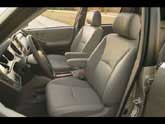
Test Drive
We drove both the 2WD and 4WD versions of the 2006 Toyota Highlander Hybrid on a variety of roads in and around the Phoenix region. Not surprisingly, we attracted no attention from fellow motorists, as the new hybrid model looks like other Highlanders and Highlanders, as attractive as they are, look a lot like many other compact SUVs on the market today.
Like most newer hybrids, the Toyota Highlander Hybrid goes quiet at stops when the engine shuts off to conserve energy, but delivers plentiful and seamless power when it's go. Not only is there no weight penalty because of its electric drive motor generator and battery, its V6 gives performance that's closer to a V8. Toyota's throttle modulation is delivered with logic. Although there is a slight delay on start, there is a smooth delivery of torque as you gain momentum. Braking is smooth, as well, and comes by a pedal that reacts gradually at its top end, and is responsive, without being harsh. Using the "B" selection for the transmission (which adds engine braking) for quicker stops increases fuel economy, but can come at a penalty of increased engine noise and a slightly jolting feel, depending on your speed when you select it. The 4WD-i system increases launch torque (if you care about 0-60 acceleration, which is 7.3 seconds according to Toyota, or need to make a quick avoidance maneuver), and also allows four-wheel regenerative energy capture. Not a full-time system, the 4WD-i uses a rear motor that activates only when increased traction is needed. Toyota engineers report this is a seamless operation and we trust them, but the dry pavement of Phoenix did not provide us with adequate opportunity to evaluate its competency, although we always felt sure-footed, even applying full power on take-offs and carving tight corners at speed.
Pushing the throttle hard in both versions brought engine noise to the interior, but we remembered that gentle application of the accelerator improves fuel economy. The Highlander Hybrid's electric rack-and-pinion steering was impressive and fast-reacting, weighted for predictable control. Computer electronics ordain precise handling, similar to the Audi A4's wonderfully-weighted turn-in, but somewhat lighter in your hands, like the Honda Pilot's tight and smooth steering. (Interestingly, the electric steering's ECU orders up steering boost based on your speed and communication with the vehicle's stability system)
The impressive array of electronics includes ABS, TRAC (traction control system that helps avoid unnecessary wheel spin); Vehicle Stability Control (VSC - for additional intervention and support when in a skidding situation); and Vehicle Dynamics Integrated Management (VDIM - which provides integration of all other traction and control systems).
Notably, the optional 4WD is not a full-time system, engaging only when needed and designed for "on-road enhancement," not for off-pavement use. When asked, Toyota engineers claimed that the wheel spin that comes with slippage on dirt, sand and other backcountry surfaces can interfere with the electronics of this hybrid model. This is different from the Ford Escape Hybrid, which Ford claims has backcountry capability.
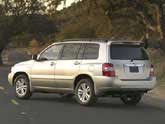
Wrap-Up
For now, any hybrid SUV is an exception. There's just nothing "normal" about one, especially one capable of running 600 miles on a tank of gas and rated a Super Ultra Low Emissions Vehicle (SULEV). But Toyota, and the other auto manufacturers, are changing this. Some will make a better showing than others, but all of the players are looking for their piece of the action in this vast, and still young, segment.
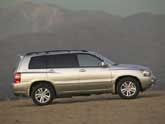
Specifications
Test Vehicle: 2006 Toyota Highlander Hybrid Price Range: $32,000-34,000 (estimated) Engine Size and Type: 3.3-liter V6 gasoline engine with Permanent Magnet electric motor (268 combined hp) Engine Horsepower: 268 combined Engine Torque: Toyota does not disclose maximum torque figures because it can't be calculated accurately. The three different components are never working together at the same time, but individual torque figures for each can be calculated on its own. For example, torque for the gasoline engine is 212 lb.-ft. at 4,400 rpm. Transmission: Continuously-variable automatic transmission Curb weight, lbs.: 3,700-3,900 (estimated) EPA Fuel Economy (city/highway): 32/27 (2WD); 30/26 (4WD) Length: 184.6 in. Width: 71.9 in. Wheelbase: 106.9 in. Height: 67.9 in. (2WD); 68.3 in. (4WD) Leg room: front - 40.7 in.; second row - 36.4 in.; third row - 30.2 in. Head room: front - 40 in.; second row - 39.3 in.; third row - 32.3 in. Max. Seating Capacity: 7passengers Max. Cargo Volume: 80.6 cu. ft. (with second and third row seats folded flat) Max. Payload:1,605 lbs. (2WD); 1,430 lbs. (4WD) Max. Towing Capacity: 3,500 lbs. Ground Clearance: 6.9 in. (2WD); 7.3 in. (4WD)
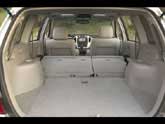
FAQs
What is the 2006 Toyota Highlander Hybrid? The 2006 Toyota Highlander Hybrid is the world's first seven-passenger hybrid vehicle. It is powered by a 3.3-liter gasoline V6 and an all-new version of Toyota's Hybrid Synergy Drive powertrain, engineered for the acceleration and load-carrying needs of a mid-size SUV. It will deliver combined city-highway fuel efficiency that is significantly better than the current EPA average for a compact sedan, and tow up to 3,500 lbs., says Toyota.
How many hybrids were sold in 2004? Despite their popularity, hybrids made up only one-half of 1 percent of total vehicle sales in the U.S. last year, or close to 88,000 vehicles. Toyota and Honda expect to double hybrid sales for 2005. There are a number of improvements or upgrades between the Prius system and the Highlander. Power is greater (268 hp./200 kW); a 3.3-liter V6 is used; the next generation nickel metal-hydride (Ni-MH) high-voltage batteries is employed complete with a 22-percent size reduction and an improved inverter to boost battery voltage; both motor generators are more powerful; and a new rear transaxle (MRG - Motor Generator Rear) is added only to 4WD models.
When does the 2006 Highlander Hybrid go on sale? The Highlander Hybrid goes on sale in June, 2005, which is two months earlier than the launch of the new 2006 Lexus 400h - the Toyota's upscale sibling. Both the Highlander and Lexus SUVs have been best sellers in their class.
How many models are available? Two trim levels are offered - Base and Limited, in either 2WD or 4WD.
Photos courtesy of Toyota
